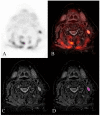Improved Cervical Lymph Node Characterization among Patients with Head and Neck Squamous Cell Carcinoma Using MR Texture Analysis Compared to Traditional FDG-PET/MR Features Alone
- PMID: 38201380
- PMCID: PMC10802850
- DOI: 10.3390/diagnostics14010071
Improved Cervical Lymph Node Characterization among Patients with Head and Neck Squamous Cell Carcinoma Using MR Texture Analysis Compared to Traditional FDG-PET/MR Features Alone
Abstract
Accurate differentiation of benign and malignant cervical lymph nodes is important for prognosis and treatment planning in patients with head and neck squamous cell carcinoma. We evaluated the diagnostic performance of magnetic resonance image (MRI) texture analysis and traditional 18F-deoxyglucose positron emission tomography (FDG-PET) features. This retrospective study included 21 patients with head and neck squamous cell carcinoma. We used texture analysis of MRI and FDG-PET features to evaluate 109 histologically confirmed cervical lymph nodes (41 metastatic, 68 benign). Predictive models were evaluated using area under the curve (AUC). Significant differences were observed between benign and malignant cervical lymph nodes for 36 of 41 texture features (p < 0.05). A combination of 22 MRI texture features discriminated benign and malignant nodal disease with AUC, sensitivity, and specificity of 0.952, 92.7%, and 86.7%, which was comparable to maximum short-axis diameter, lymph node morphology, and maximum standard uptake value (SUVmax). The addition of MRI texture features to traditional FDG-PET features differentiated these groups with the greatest AUC, sensitivity, and specificity (0.989, 97.5%, and 94.1%). The addition of the MRI texture feature to lymph node morphology improved nodal assessment specificity from 70.6% to 88.2% among FDG-PET indeterminate lymph nodes. Texture features are useful for differentiating benign and malignant cervical lymph nodes in patients with head and neck squamous cell carcinoma. Lymph node morphology and SUVmax remain accurate tools. Specificity is improved by the addition of MRI texture features among FDG-PET indeterminate lymph nodes. This approach is useful for differentiating benign and malignant cervical lymph nodes.
Keywords: PET-MRI; cervical lymphadenopathy; machine learning; squamous cell carcinoma; texture analysis.
Conflict of interest statement
The authors declare no conflicts of interest.
Figures




References
-
- Som P.M., Brandwein-Gensler M.S. Lymph nodes of the neck. In: Som P.M., Curtin H.D., editors. Head and Neck Imaging. Mosby; St. Louis, MO, USA: 2011.
-
- Kostakoglu L. PET/CT imaging. In: Som P.M., Curtin H.D., editors. Head and Neck Imaging. Mosby Elsevier; St. Louis, MO, USA: 2011.
LinkOut - more resources
Full Text Sources

